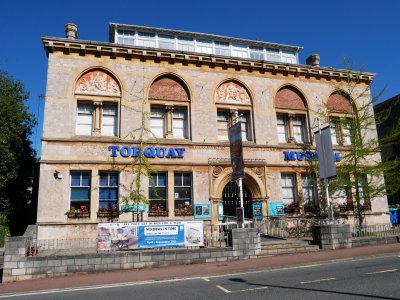
Torquay Museum / News / Wed 02 Nov 2011
Jawbone - Earliest Evidence of Modern Humans in NW Europe

Torquay Museum’s Jawbone is Earliest Evidence of Modern Humans in North-western Europe, According to New Study by Experts
Experts from the University of Oxford and the Natural History Museum in London have discovered that Torquay Museum’s world famous Kent’s Cavern jawbone is between 41,500 and 44,200 years old - up to 7,000 years older than previously thought - making it the oldest anatomically modern human fossil in north-western Europe.
This amazing discovery, published today (Wednesday 2nd November) in the internationally renowned science magazine Nature, comes after the Kent’s Cavern jawbone was re-dated by Dr Thomas Higham of the University of Oxford and Professor Chris Stringer of the Natural History Museum in London, using a more sophisticated and accurate dating technique than those used previously.
Unearthed in 1927 during an archaeological excavation of Kent’s Cavern by the Curator of Torquay Museum, it wasn’t until 1989 that the great age of the jawbone was discovered after it was radiocarbon dated and thought then to be 31,000 years old.
Finds of stone tools may indicate that the earliest modern humans appeared across Europe sometime before 40,000 years ago. The physical evidence for these early humans is extremely rare.
“This discovery emphasises the status of Kent’s Cavern as one of the most important archaeological sites in Europe,” said Barry Chandler, Curator of Collections at Torquay Museum and one of the authors of the research paper in Nature magazine. “It’s amazing to think that over 40,000 years ago humans, much like ourselves, were sheltering in Kent’s Cavern, hunting game in the cold open grasslands that surrounded Torquay at that time. They were the earliest human settlers in Britain.”
“These early humans shared the cold Torquay landscape with Neanderthals, woolly mammoths, hyenas, woolly rhinos, giant deer, bears and scimitar cats – a very challenging world, to say the least,” continued Barry.
A huge wealth of information about the early humans and animals that lived in and around Kent’s Cavern over the past half a million years has been collected, analysed and catalogued by Torquay Museum – from beautiful and ancient man-made stone tools to the fossilised bones of huge and exotic animals. Many of these artefacts can be seen displayed at the Museum, including the famous jawbone. A fascinating temporary exhibition at Torquay Museum, entitled Ancestors, explores half a million years of prehistory – from the first of our ancestors to set foot in Devon to the end of the Stone Age.
Nick Powe, fifth generation owner of Kent’s Cavern comments: “This is hugely exciting news for Kent’s Cavern, as mounting interest in the origins of humankind means this news is likely to increase international interest in the cave. Kent’s Cavern has always been one of the UK’s classic prehistoric caves and this research elevates the cave’s status to a whole new level. Confirmation that the jawbone is modern human, and contemporary with Neanderthals, makes Kent’s Cavern the earliest modern human settlement in north-western Europe and places it in the top league of Ice Age sites on the planet.”
Media interest in this story has already been intense – with BBC TV Science Unit and Channel 4 News visiting both Torquay Museum and Kent’s Cavern.
For more information visit http://www.torquaymuseum.org/
News Location
Website: http://www.torquaymuseum.org/
